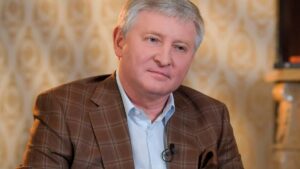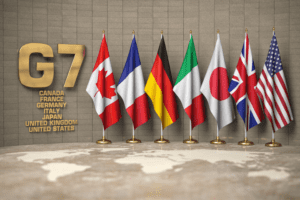
The Ministry of Agrarian Policy and Food of Ukraine is working to extend the abolition of duties and quotas for the import of agricultural products to the EU countries for the entire period of its candidacy for the EU, as well as to harmonize Ukrainian legislation with the European one.
The integration prospects in the context of Ukraine obtaining the status of a candidate for EU membership were announced by First Deputy Minister Taras Vysotsky at a meeting with the European Business Association (EBA) on June 22, according to the EBA website on Friday.
According to the organization, in addition to the abolition of quotas and duties from the EU in early July, it is planned to cancel licenses for the export of Ukrainian wheat to the EU countries.
Also, in order to open alternative logistics routes, the ministry is negotiating with countries on the use of the Baltic and Polish corridors for the export of agricultural products.
“To support the dairy industry, the Ministry of Agrarian Policy is negotiating with the European Commission to provide grants of up to EUR 50 million to small farmers, and the possibility of submitting them to other international support programs is being considered,” EBA quotes Vysotsky.
The association noted that in the near future it is planned to separate queues for customs clearance of goods with perishable products at two checkpoints on the border with Poland – in Krakovets and Yahodyn.
As reported, on June 4, Regulation of the European Parliament and of the Council No. 2022/870 on temporary trade liberalization measures, exempting Ukrainian exports from all duties and quotas for a year, came into force.

The Polish railway company PKP Intercity is canceling free travel for Ukrainian citizens from July 1, the company’s press service said.
“The current rules for issuing free tickets for refugees from Ukraine will be valid until Thursday, June 30. From Friday, July 1, these trips will be carried out according to the general rules included in the PKP Intercity regulations.
It is noted that free travel for citizens of Ukraine in the 2nd class of economy class trains TLK and IC was introduced on February 26. Until the last days of June, more than 2.3 million citizens of Ukraine used the services of PKP Intercity.

Businessman Rinat Akhmetov has filed a lawsuit against the Russian Federation with the European Court of Human Rights (ECHR) over Russia’s military aggression against Ukraine.
This was reported by the press service of the SCM company.
“Evil cannot go unpunished. Russia’s crimes against Ukraine and every Ukrainian are egregious. The guilty must be punished. I – with the help of the best Ukrainian and American lawyers – filed a complaint with the European Court of Human Rights for damages. This lawsuit is one of the first international legal actions against Russia, the purpose of which is to stop the criminal activities of the Russian aggressor, the destruction of the Ukrainian economy and the plundering of Ukrainian assets,” Rinat Akhmetov said.
The businessman asks the European court to hold the aggressor country Russia accountable for the destruction of Ukrainian infrastructure, looting and theft of export goods. He is represented by the international law firm Covington & Burling LLP.
As the owner of Azovstal and many other industrial enterprises targeted by the Russian armed forces invading Ukraine, Akhmetov is doing everything possible to hold Russia accountable for the destruction it is wreaking on Ukrainian territory, SCM noted.
In addition to the lawsuit, the businessman asks the court to take urgent interim measures that will prevent further blockade of Ukrainian ports, looting, theft of grain, as well as steel produced by SCM enterprises.
“The looting of Ukrainian export commodities – including grain and steel – has already driven up the price of those commodities and increased the number of people in the world who are dying of hunger. This barbarity must be stopped and Russia must pay in full. I believe in justice and fight for it,” said Rinat Akhmetov.
He also urges other businessmen affected by Russian aggression to go to court.

The Cabinet of Ministers allowed for the period of martial law and within a year after it to build individual houses and farm buildings without obtaining a construction passport for the development of a land plot, Taras Melnychuk, a representative of the Cabinet of Ministers in the Verkhovna Rada, said on his Telegram channel.
According to him, the condition is valid for individual, garden, country housing no higher than two floors and an area of up to 500 square meters.
The construction of such houses shall be carried out in accordance with urban planning documentation at the local level, and in its absence – in accordance with the intended purpose of the land.
BUILDING INDIVIDUAL HOUSING, CONSTRUCTION PASSPORT, MARTIAL LAW

The National Bank of Ukraine expects that the majority of Ukrainian banks will be able to independently restore capital after military losses thanks to future profits, but the rest may require additional capitalization from the shareholder.
“In particular, this is a possible scenario for several state-owned banks,” the NBU noted in its Financial Stability Report.
The regulator indicated that during the crisis it will not apply measures of influence to banks for violating capital requirements.
“At the same time, at this stage, it is important that banks reflect credit losses in a timely manner. This will give the NBU a correct idea of the state of the market for making further regulatory decisions, in particular, adjusting the regulatory easing regime,” the document says.
It does not specify which state-owned banks are in question, but indicates that some state-owned banks “failed” in terms of capital.
According to the report, of the 20 largest banks, they show sufficient resistance to the loss of 30% of the loan portfolio of financial institutions, which collectively own more than half of the assets of the top 20.
“If we add the share of state-owned banks that “failed” in terms of capital, but have unconditional support from the state, then it can be argued that banks with 82% of the assets of the 20 largest have sufficient resistance to such an extremely conservative macroeconomic scenario,” said the National Bank.
The regulator added that banks that consistently generate negative operating cash flow from core activities during the crisis will be subject to close supervision and their activities will, under certain circumstances, be restricted to protect depositors.
The NBU pointed out that the negative impact of the current crisis will stretch over time – it will be possible to assess its consequences relatively accurately only after stabilization of macroeconomic conditions. At the same time, the National Bank will assess the quality of assets in order to reliably estimate the level of losses, while the viability of banks will be assessed separately, that is, the ability to normalize financial indicators in the foreseeable future.
Given the level of losses, a sufficient period will be determined for the banks to restore capital, possibly several years, the report says. Banks will have to develop capitalization and asset restructuring plans.

The leaders of the G7 countries will announce the provision of new financial, humanitarian and military support to Ukraine, Bloomberg reports citing a draft statement of these countries from the summit in Bavaria.
“We will continue to provide financial, humanitarian, military and diplomatic support to Ukraine, as well as support it for as long as necessary,” the agency quotes from a document received by it.
Bloomberg emphasizes that this “wording is important because the members of the G7 are concerned about the prolongation” of the war. However, some countries, including Germany and France, “have hinted that they may be more open to the idea of a negotiated ceasefire.”
According to the agency, the document says that the leaders of the G7 are also considering the possibility of using revenue from duties to support Ukraine.
It is noted that earlier the G7 discussed how to coordinate actions to combat rising inflation and prevent a recession, as well as ways to maintain “pressure on Russia.”
The G7 summit is taking place in Bavaria on June 26-28.